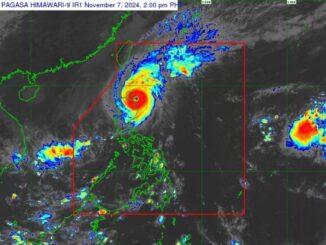
MANILA, Philippines — Typhoon Julian reentered the Philippine area of responsibility (PAR) yesterday but will no longer have any direct effect on the country, according to the Philippine Atmospheric, Geophysical and Astronomical Services Administration (PAGASA).
Julian was forecast to make landfall and start traversing Taiwan starting yesterday.
It was monitored 255 kilometers northwest of Itbayat as of 5 p.m., with maximum sustained winds of 120 km/h near the center and gustiness of up to 200 km/h.
Julian was forecast to become a remnant low over Taiwan by today.
It will bring scattered rains over Batanes and Babuyan Islands while its trough will also bring rains over Ilocos region, Apayao, Abra, Kalinga, and mainland Cagayan.
Central Luzon, the rest of Cordillera Administrative Region (CAR), and the rest of Cagayan Valley may see isolated rains due to localized thunderstorms. Metro Manila and the rest of the country may see isolated rains due to the easterlies.
Typhoon Julian – which brought heavy rains, flooding and landslides in northern Luzon – left at least two people dead, eight people injured, and one person still missing, according to the National Disaster Risk Reduction and Management Council (NDRRMC).
In a report, the NDRRMC said the two fatalities are from the Ilocos region and CAR. The eight people injured and one person reported missing were also from the same regions.
The NDRRMC said a total of 58,953 families or 211,000 people in the Ilocos, CAR and Cagayan Valley were affected.
Of the number, some 308 families or 922 people still remain in 26 different evacuation centers in affected provinces where their basic needs are being provided.
The damage of Typhoon Julian to the agriculture sector in the CAR, Ilocos (Region 1) and Central Luzon (Region 3) has reached P481.27 million, according to the Department of Agriculture (DA).
The damage was recorded in rice, corn, high value crops, livestock, poultry and irrigation facilities affecting 20,134farmers, covering 13,488 hectares of agri-
cultural areas and volume of production loss at 19,151 metric tons. – Michael Punongbayan, Bella Cariaso





Be the first to comment